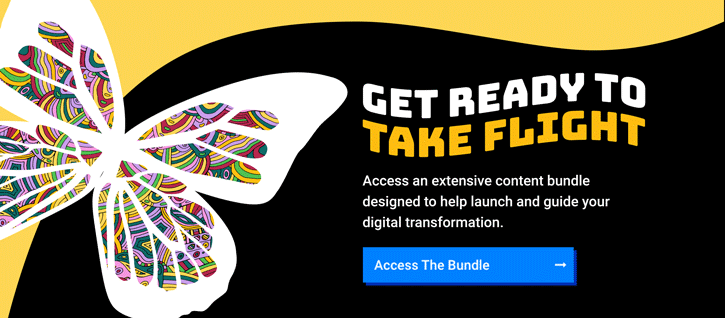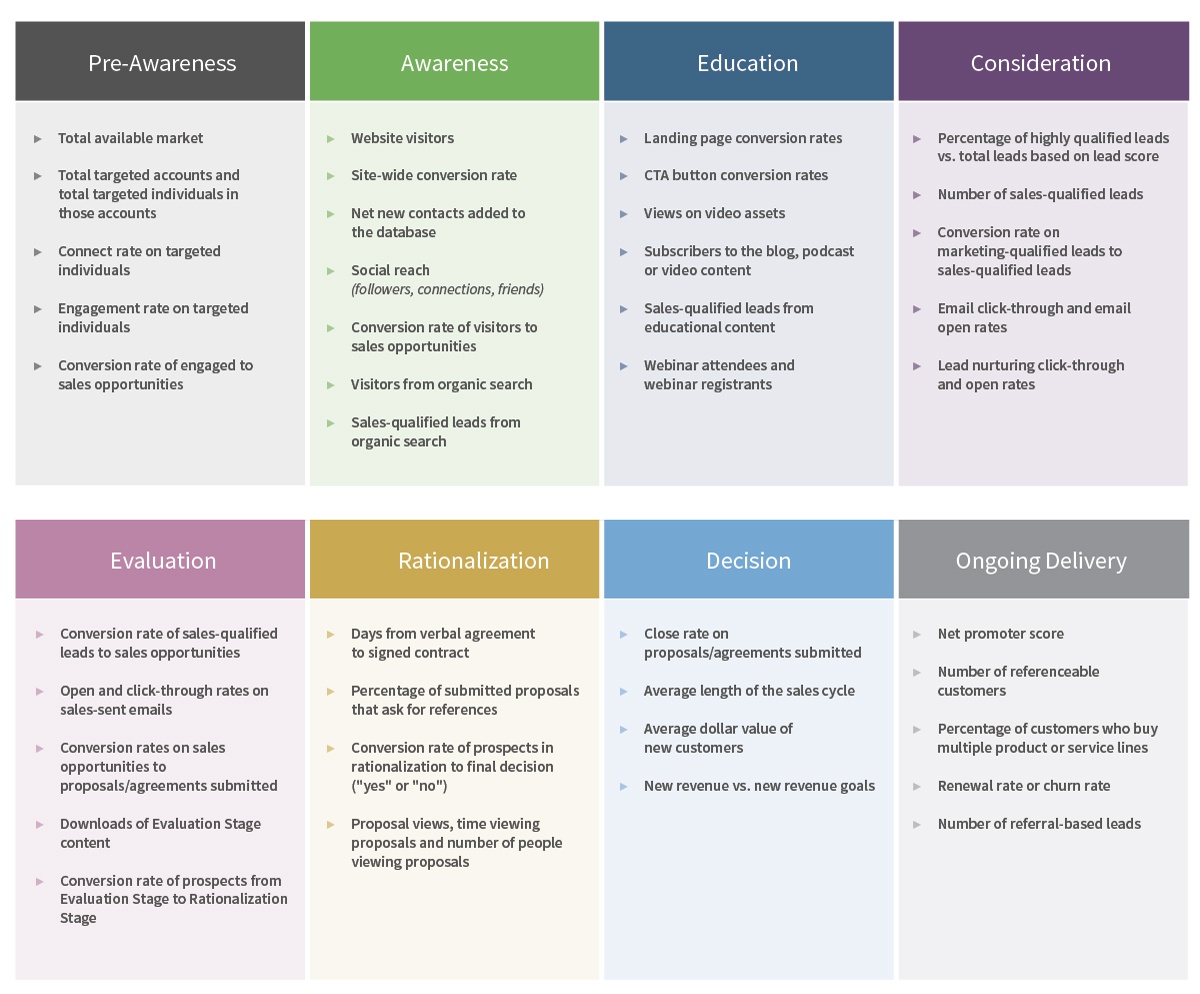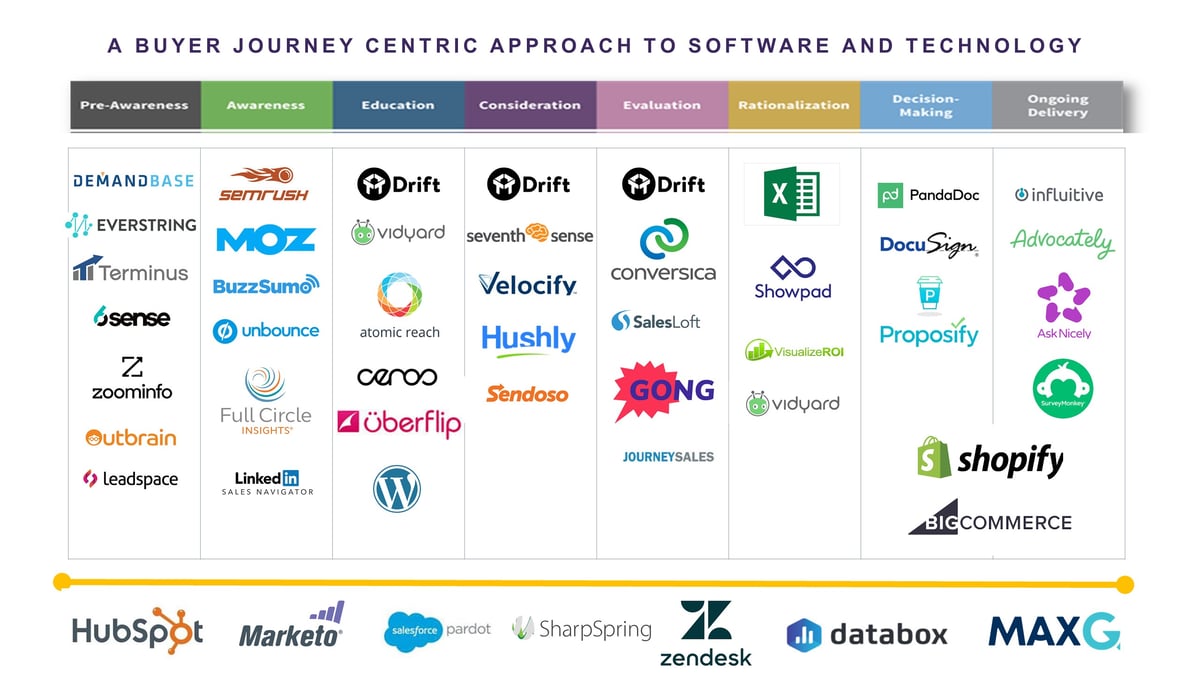The New Buyer Journey
And Why The Sales Funnel Is Failing You
The traditional sales funnel no longer accurately reflects how today's prospects buy. The new buyer journey underscores the radical shift in how customers make purchase decisions in a digital omnichannel world while providing a detailed blueprint for delivering a better customer experience.
What Is the Buyer Journey?
Buyer journey. Customer journey. Purchase journey.
These are three terms for a single concept. Very simply, the buyer journey describes what happens between the time a person becomes aware of a product or service and when they become a customer.
Traditionally, marketers have looked at the milestones of the buyer journey as rigid, linear and limited steps that involved research, decision-making and purchasing. However, that’s an oversimplification of the process.
We now know that the buyer journey is incredibly complex. It is, in the truest sense, a journey – full of twists and turns, rife with challenges and obstacles. Yet too many businesses have been slow or resistant to adopt this view. As a result, they’ve not only failed to deliver the ideal customer experience, they’re unwittingly hurting their own sales.
The time has come to redefine the buyer journey for the digital age, and account for the multitude of factors that influence a purchase.
Most Companies Don’t Hit Their Sales Goals
Would you be surprised to learn that most companies routinely miss their sales goals? Statistics show that between 50% and 70% of companies fail to reach their stated objectives.
That’s a staggering number. To some, it may even sound unbelievable. But a recent Salesforce study reported that 57% of sales reps missed their quota last year. And only 23% of participants surveyed by HubSpot said they were exceeding their goals. So ask yourself:
- Are you hitting your revenue targets?
- Do you have enough leads?
- Can you get high-quality sales opportunities for your sales team?
- Does your team turn those opportunities into new customers?
If you can’t honestly answer “yes” to all of those questions, there’s probably a gap between your business objectives and your strategy (or lack thereof) for achieving them.
But the problem runs deeper than a simple gap analysis of goals and
Want to generate sustainable, predictable and repeatable revenue?
Smash the funnel.
What Is a Sales Funnel? The AIDA Model
Conceived in 1898 by E. St. Elmo Lewis, the sales funnel was created as a way to help visualize the customer journey, from the moment people first become aware of a product to the time they become a customer. It’s also known as the AIDA model, an acronym that describes each stage of the buyer journey.
Elegant and easy to understand, the traditional sales funnel offered a simple illustration of how people make purchases. They come into the top of the funnel as prospects and come out the bottom as new customers, passing through three buying stages (slightly revised from the original AIDA model): awareness, consideration
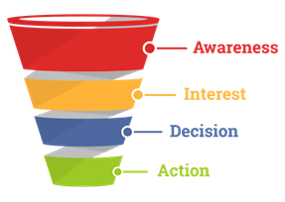
For over 100 years, the funnel has been marketing dogma, unchallenged and unchanged. Think about that for a moment. We’ve been selling cars using a sales model that long predates the Model T. And we continue to rely on it in the digital age, even though it predates the internet and social media, and doesn’t account for either.
We have boldly developed technology to take us deep into
The Sales Funnel Is Dead
When salespeople controlled the entire buyer journey, the funnel made sense. It served as a fairly accurate representation of how people made purchases. But things have changed, and changed dramatically, in recent years.
Today, buyers are in control.
Like so much of modern life, technology has drastically altered the buyer journey. The wealth of information available, and our ability to access it at any
The average adult spends over 12 hours a day consuming media.
We are overwhelmed with information, and not all of it is in agreement. As a result, buyers no longer follow a linear process with a clearly defined beginning, middle
Suffice to say, the funnel is no longer an accurate representation of what prospects experience. And it simply doesn’t offer a realistic road map to guide them through this new chaotic buyer journey.
Introducing the Cyclonic Buyer Journey™
In theory, all of this readily available information should help educate prospects and streamline the buying experience, but it has had the opposite effect. Information overload has extended the customer journey and infected it with uncertainty, anxiety
The modern buyer journey is a violent and unpredictable storm. Prospects are pushed and pulled in every direction by disparate (and often conflicting) information. No longer linear, the buyer journey is now cyclical.
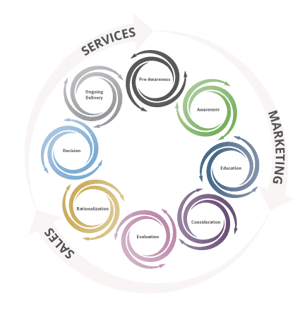
Prospects don’t all enter at the awareness phase. They can enter at any stage, and can encounter information from any stage at any time. They can bounce back and forth among stages or even become stuck in a stage. It’s a dizzying storm, and your prospects are lost in it.
Forget the funnel. It has been replaced by a revolutionary new view – the Cyclonic Buyer Journey model. Using a series of interconnected cycles, it accurately depicts the chaotic experience and torrent of information prospects face.
To mirror that complex journey and account for the myriad sources of information that affect the decision-making process, the Cyclonic Buyer Journey features eight distinct stages.
What Is the Cyclonic Buyer Journey?
The Cyclonic Buyer Journey is a model introduced in early 2018 by Square 2 co-founders Mike Lieberman and Eric Keiles. In this model, buyers go through eight distinct “cyclones” on their way to a complex purchasing decision, and can move both backward and forward through their journey. It is considered a replacement to the traditional sales funnel.
The 8 Stages of the New Cyclonic Buyer Journey
Pre-Awareness
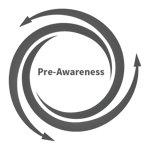 Some prospects don’t know you exist. They have the specific pain, issue or challenge that you help with, but for whatever reason, they don’t realize solutions are available. Since they’re not aware, we call that pre-awareness.
Some prospects don’t know you exist. They have the specific pain, issue or challenge that you help with, but for whatever reason, they don’t realize solutions are available. Since they’re not aware, we call that pre-awareness.
However, a pain trigger can move them from pre-awareness to awareness. That trigger can be internal or external, so you can provide it. When you deliver a disruptive, emotional and compelling message to a prospect in pre-awareness, you can wake them up, get them scared or move them to act because of the emotion your message stirs up.
Awareness
 Awareness is the stage when people start paying attention to potential solutions. It’s when they might be open to information related to their issue, pain or challenge. In this stage, they are still reactive and not yet proactive.
Awareness is the stage when people start paying attention to potential solutions. It’s when they might be open to information related to their issue, pain or challenge. In this stage, they are still reactive and not yet proactive.
If you think about your own behavior, typically this starts with asking friends, family, colleagues, peers or associates if they know anything about the issue you’re looking into. This might be quickly followed by (or done in conjunction with) an online search.
Education
 The next phase is education, this stage is when prospects start proactively looking for information or research around the possibility of doing (or buying) something different from what they’ve been doing (or buying).
The next phase is education, this stage is when prospects start proactively looking for information or research around the possibility of doing (or buying) something different from what they’ve been doing (or buying).
Once people are aware that a solution exists, or that they have a situation that needs their attention, they go about getting educated on their options. This is a separate stage today because the content available for educating prospects is so massive: the entire internet.
Consideration
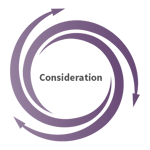 Eventually, prospects have to start narrowing down their options. They discover what they like and don’t like, and what they need and don’t need.
Eventually, prospects have to start narrowing down their options. They discover what they like and don’t like, and what they need and don’t need.
When they have narrowed down the potential solutions to just a few, they enter into the consideration stage, where they start to look more closely at their selected handful of options.
This is where guidance becomes critical. Remember, it’s not a funnel anymore. It’s a series of chaotic informational cycles. If you want to help your prospect navigate through the storms, you have to be able to show them clearly what makes your option different – better, faster, cheaper, more strategic and more valuable – than the other handful of options
Evaluation
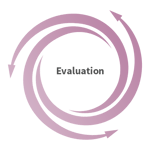 Now that the prospects are serious, the hard work of evaluation begins. Most of their questions were handled by the website but now require one-on-one conversations. This stage is typically where sales gets involved. One or two people may have done the research and background work, but now that they’re looking at pricing, capabilities, features, and benefits, the power people are involved.
Now that the prospects are serious, the hard work of evaluation begins. Most of their questions were handled by the website but now require one-on-one conversations. This stage is typically where sales gets involved. One or two people may have done the research and background work, but now that they’re looking at pricing, capabilities, features, and benefits, the power people are involved.
Your job? Stand out. Make sure that when their process is over, no choice needs to be made. You stand out as the only company, product or service for them.
Rationalization
 This stage is where prospects ask the tough questions: When do you expect me to see a positive ROI on the investment? What are your payment terms and are they flexible? Who, specifically, will we be working with on this project? When do you expect delivery to be completed?
This stage is where prospects ask the tough questions: When do you expect me to see a positive ROI on the investment? What are your payment terms and are they flexible? Who, specifically, will we be working with on this project? When do you expect delivery to be completed?
Your prospect has already emotionally decided on you as a viable option, but now needs to develop a rationalization for their decision. Resolving these questions is usually a hurdle, so your sales process needs to be buttoned up and remarkable.
Decision
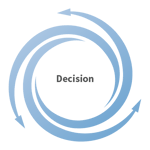 Even after officially making the decision, the buyer still has to talk about contract details, agreement terms and other legal aspects of their new working relationship. It’s not final until the paperwork is signed.
Even after officially making the decision, the buyer still has to talk about contract details, agreement terms and other legal aspects of their new working relationship. It’s not final until the paperwork is signed.
You want to focus on what makes your company special. The more unique you are, the more leverage you have to say “no” to disadvantageous terms. The more generic your offering is, the more likely you’re going to run into issues here.
Consider procurement, for example. If the prospect can’t get what you offer from anyone else, how aggressive are they going to be in working to get your price down? But if all three of your competitors offer the same (or similar) products or services, you have less leverage.
Ongoing Delivery
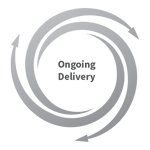 The end game is not getting a new customer but rather getting a new customer to realize the benefits they signed up for when they met you. Your goal is to create a customer so happy that they tell everyone about you, buy more from you, and continue working with you into year two. Delivery ensures your customers are an active advocate for your company.
The end game is not getting a new customer but rather getting a new customer to realize the benefits they signed up for when they met you. Your goal is to create a customer so happy that they tell everyone about you, buy more from you, and continue working with you into year two. Delivery ensures your customers are an active advocate for your company.
That final decision cycles you into a series of additional cycles as your new customer considers more services, increasing their spend with you and becoming a vocal advocate for your company. Ongoing delivery is a never-ending cycle (or at least that’s how you should look at it).
Deliver a Better Customer Experience
A too-simple view of the buyer journey isn’t the only failure of the traditional sales funnel. It’s not even its biggest crime. At a time when customer experience is paramount, the funnel doesn’t accurately explain how people experience buying, or instruct businesses on how to improve upon that experience.
That’s what makes the Cyclonic Buyer Journey unique and effective. It not only forces you to see the buying experience through the eyes of your customers,
Create a Customer Journey Map
Just as the sales and marketing funnel no longer works, the old marketing and sales playbook doesn’t work as it used to, either. You can’t cold call and sell your way into sustainable, predictable and repeatable revenue generation.
In the Cyclonic Buyer Journey, you have to earn attention and get found by creating disruptive and compelling content, including your own company story. The challenge becomes this:
How do you deploy the set of tactics and tools at your disposal, with the new Cyclonic Buyer Journey as the strategy behind your tactics?
Here’s how to support the Cyclonic Buyer Journey with tactics mapped to each stage:
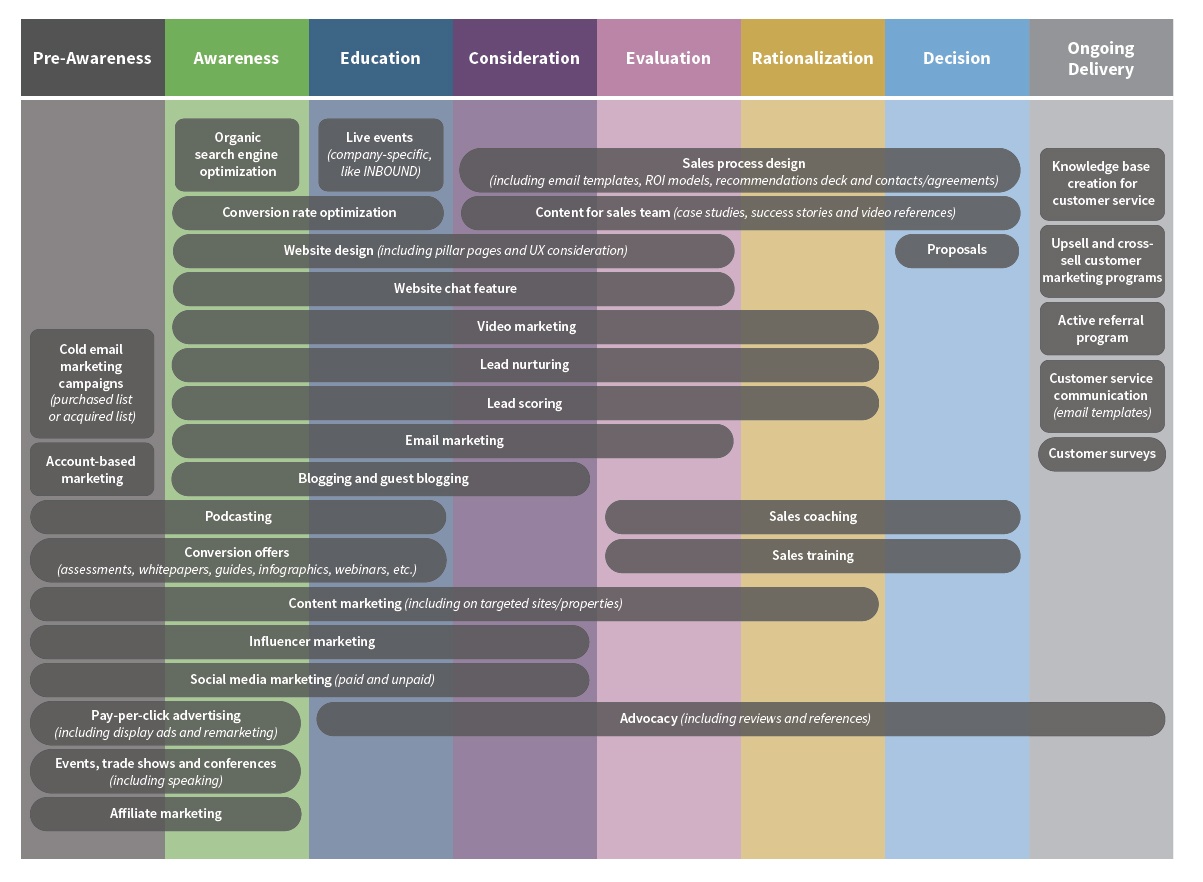
Use Customer Analytics To Track Every Cycle
You can only judge the effectiveness of tactics by monitoring performance metrics. For each stage of the new Cyclonic Buyer Journey, be sure to measure the associated metrics.
Apply the Right Technology to Each Buying Stage
Technology continues to make inroads with marketing, sales and customer service. The Cyclonic Buyer Journey model calls for technologies that are integrated and tested to work together to give you all of the data, insights and advantages you need to get you to your goals.
The following list is more of a wish list than an actual shopping list for most companies. While it’s highly unlikely you would use all of the tools listed, it’s important to understand how different technologies help you implement the tactics and measure the metrics in each stage of the new buyer journey.
Guide Your Customers Through a Better Experience
Change isn’t easy, which makes a paradigm shift even more challenging. The traditional sales funnel is so ingrained in marketing and sales thinking that, for some, it’s difficult to see the world any other way.
But the need to move away from funnel vision is about more than just its age. While its bottom-down view of sales and marketing once worked well, that view is just too narrow to account for an ever-expanding digital world. As a result, it’s failing both you and your customers.
For many, the Cyclonic Buyer Journey represents a radical shift – until you consider your own buying habits. Think about your last big purchase:
- How many product descriptions did you compare?
- How many reviews did you read?
- How often did you go back and forth about brands or models?
- Did the opinion or purchases of friends and family have an impact?
- Did your customer experience play any part in your final decision?
These are all common experiences, ones we can all relate to and have all experienced. And those common experiences are the basis of the Cyclonic Buyer Journey. It’s as natural as it is obvious, and it serves to help realign your strategies with the way people actually experience buying.
If you want to improve revenue generation, you have only one option: Smash your funnel, and start thinking about marketing and sales from a new perspective.













